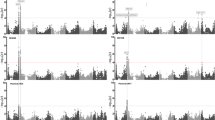Summary
Seed and embryo development was studied in crosses between H. bulbosum and the barley genotypes VK 16032, ‘Vada’ and ‘Vogelsanger Gold’ and subsequently the F1 and F2 progenies from VK 16032 x ‘Vada’ and VK 16032 x ‘Vogelsanger Gold’. Both seed and embryo development are strongly influenced by the barley genotype. Favourable environmental conditions can promote seed and embryo development in genotypes with existing good characters. Dominant inheritance for good seed development and incomplete dominance for large embryos is evident. Linkage between small embryo size and winter habit exists in ‘Vogelsanger Gold’.
Similar content being viewed by others
References
Adamski, T., 1979. The obtaining of autodiploid barley lines using haploids from the cross Hordeum vulgare L. x Hordeum bulbosum L. Genetica Polonica 20: 31–42.
Björnstad, Å., 1986. Partial incompatibility between Scandinavian six-rowed barleys (Hordeum vulgare L.) and Hordeum bulbosum L., and its genetical basis. Hereditas 104: 171–191.
Devaux, P., 1986. Yield of haploid production through the bulbosum method in a winter barley breeding programme. Cereal Res Comm 14: 273–274.
Deveaux, P. Adamski & M., Surma, 1990. Studies on low crossabilities e encountered with the Hordeum bulbosum method for haploid production of barley, Hordeum vulgare L. Plant Breeding 104: 305–311.
Hayes, P.M. & F.Q., Chen, 1989. Genotype variation for Hordeum bulbosum L.-mediated haploid production in winter and facultative barley. Crop Sci 29: 1184–1188.
Kasha, K.J. & K.N., Kao, 1970. High frequency haploid production in barley (Hordeum vulgare L.). Nature 225: 874–875.
Pickering, R.A., 1980. Attempts to overcome partial incompatibility between Hordeum vulgare L. and H. bulbosum L. Euphytica 29: 369–377.
Pickering, R.A., 1983a. The location of a gene for incompatibility between Hordeum vulgare L. and H. bulbosum L. Heredity 51: 455–459.
Pickering, R.A., 1983b. The influence of genotype on doubled haploid barley production. Euphytica 32: 863–876.
Pickering, R.A. & J.D., Hayes, 1976. Partial incompatibility in crosses between Hordeum vulgare L. and H. bulbosum L. Euphytica 25: 671–678.
Pickering, R.A. & W.F., Rennie, 1990. The evaluation of superior Hordeum bulbosum L. genotypes for use in a doubled haploid barley breeding programme. Euphytica 45: 251–255.
Simpson, E., J.W., Snape & R.A., Finch, 1980. Variation between Hordeum bulbosum genotypes in their ability to produce haploids of barley, Hordeum vulgare. Z. Pflanzenzüchtg. 85: 205–211.
Thörn, E.C., 1991. Crossability barriers between barley (Hordeum vulgare L.) and H. bulbosum L.. Genetic studies of the partial incompatibility mechanisms in the barley cultivars ‘Vada’ and ‘Vogelsanger Gold’. Hereditas 114: 213–218.
Author information
Authors and Affiliations
Rights and permissions
About this article
Cite this article
Thörn, E.C. The influence of genotype and environment on seed and embryo development in barley (Hordeum vulgare L.) after crossing with Hordeum bulbosum L.. Euphytica 59, 109–118 (1992). https://doi.org/10.1007/BF00041261
Received:
Accepted:
Issue Date:
DOI: https://doi.org/10.1007/BF00041261



